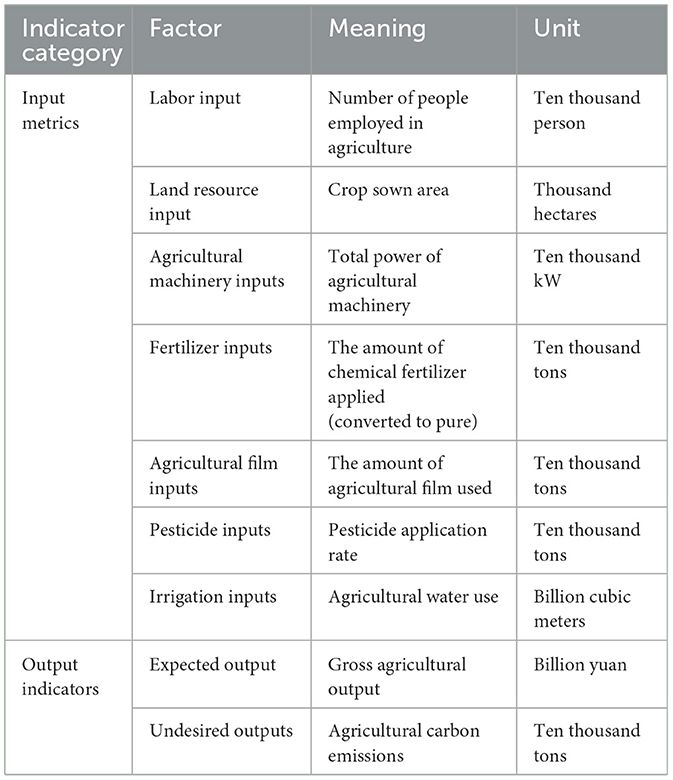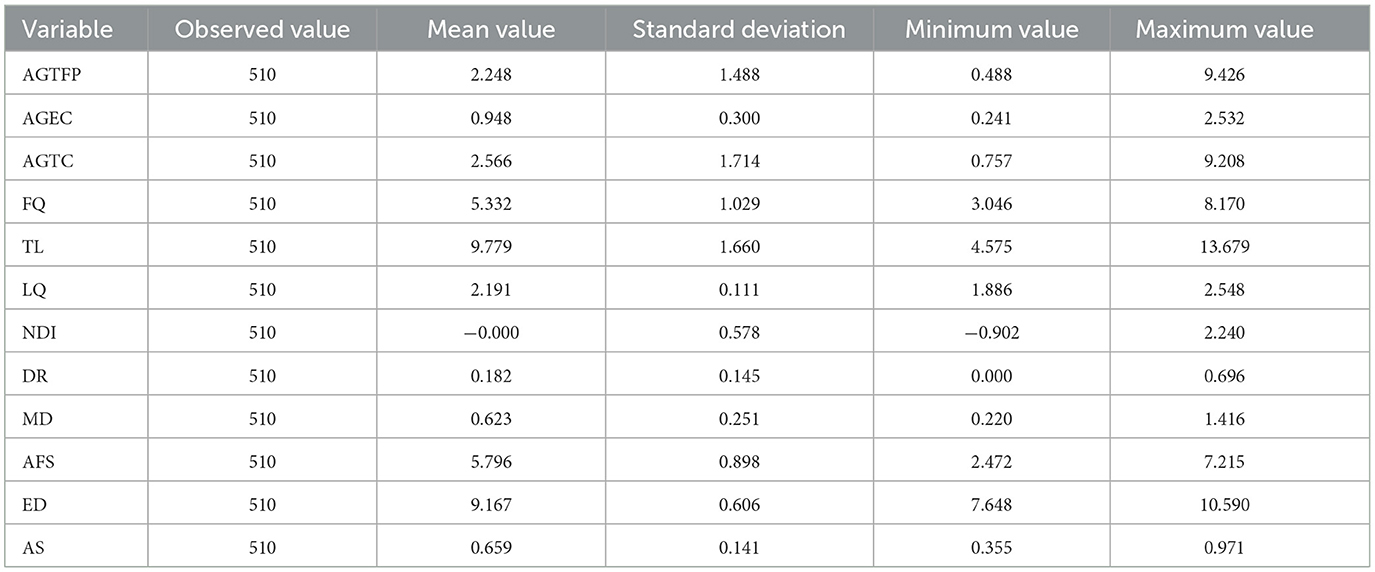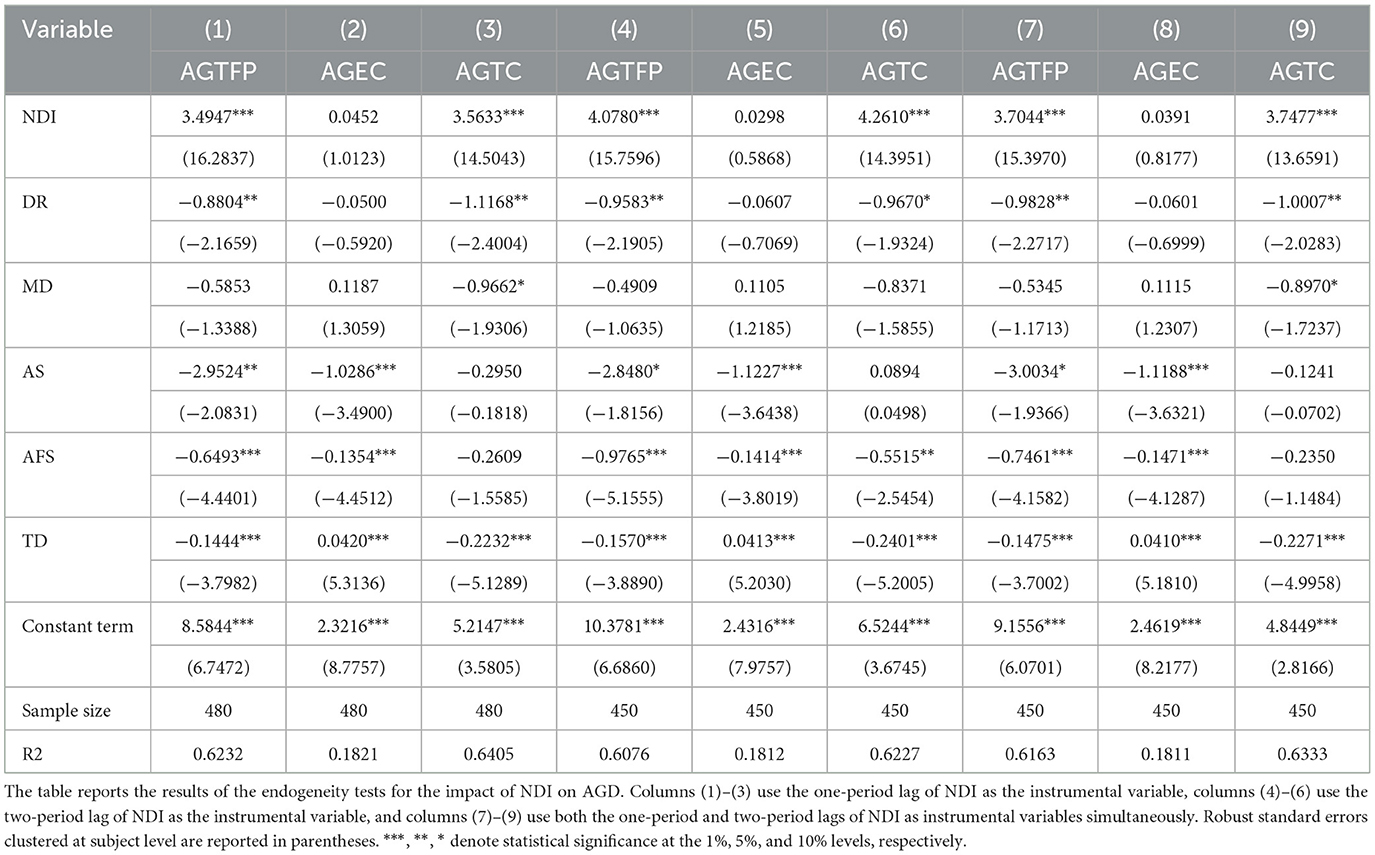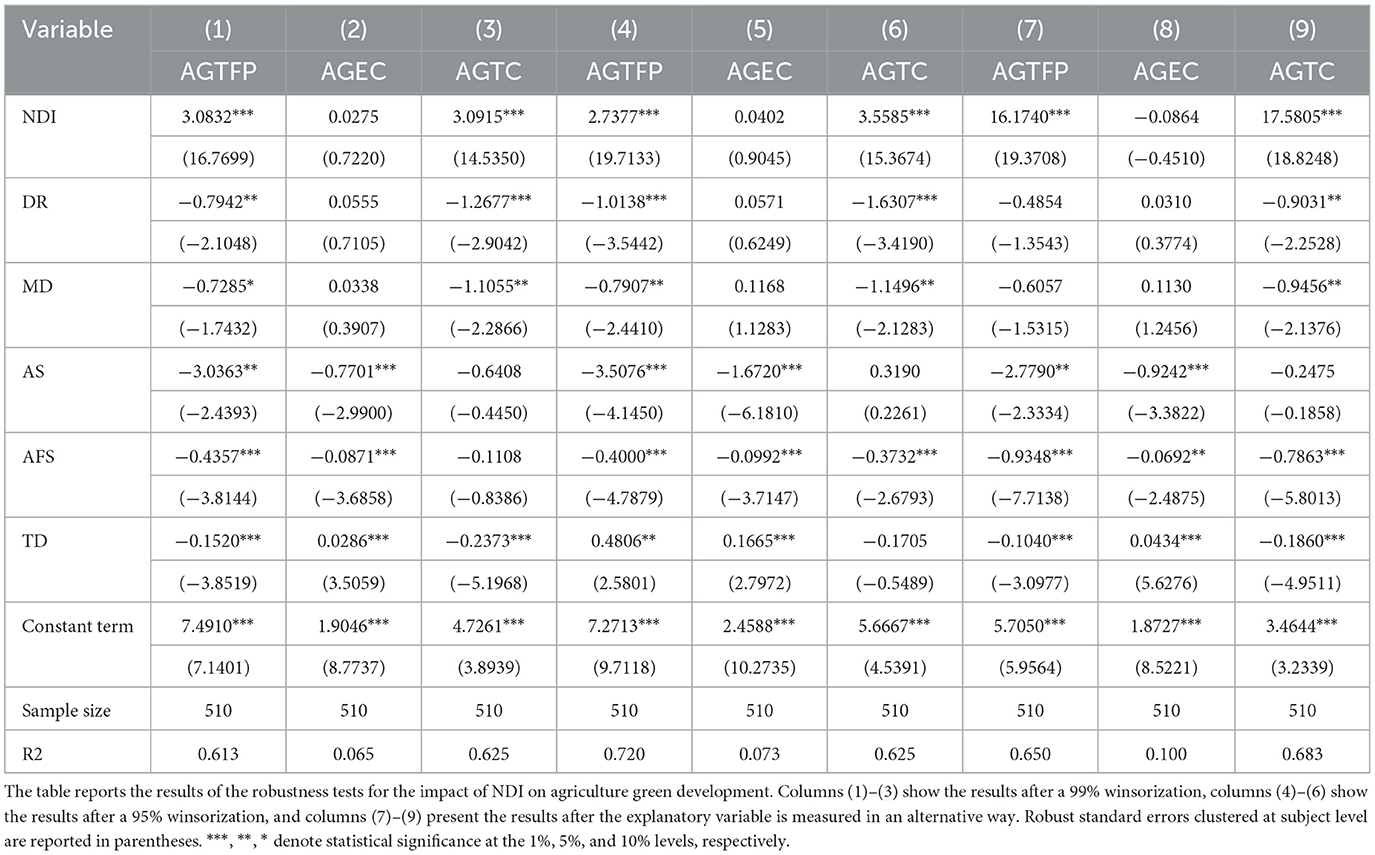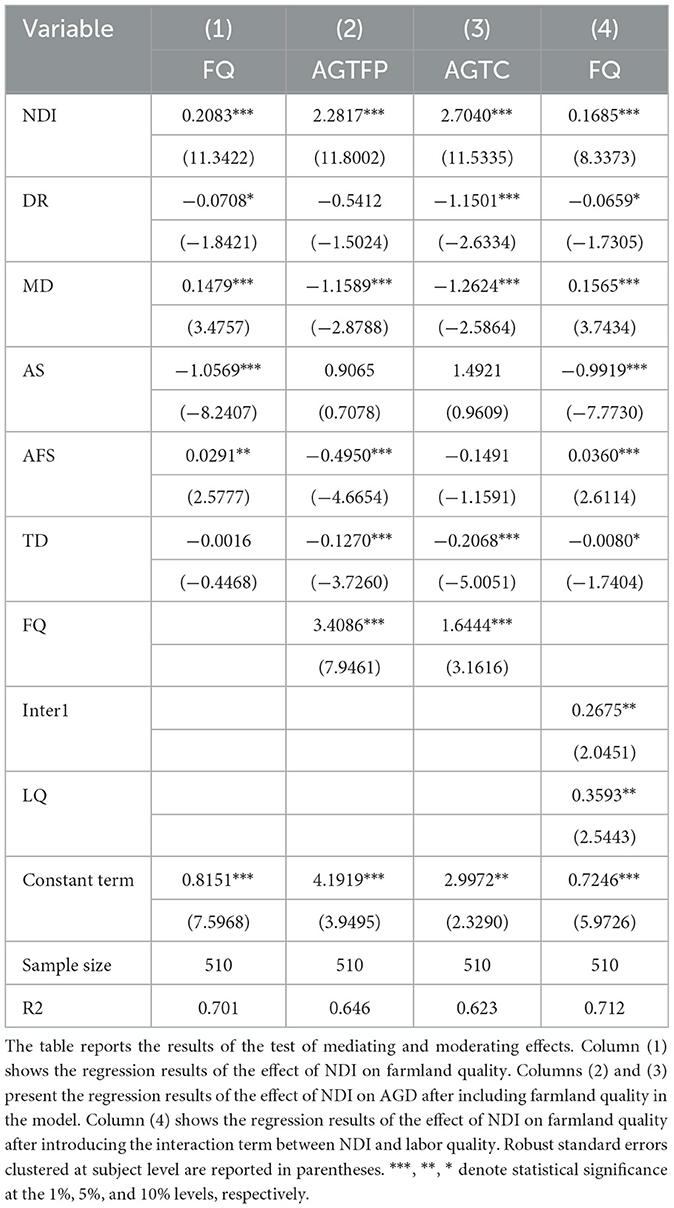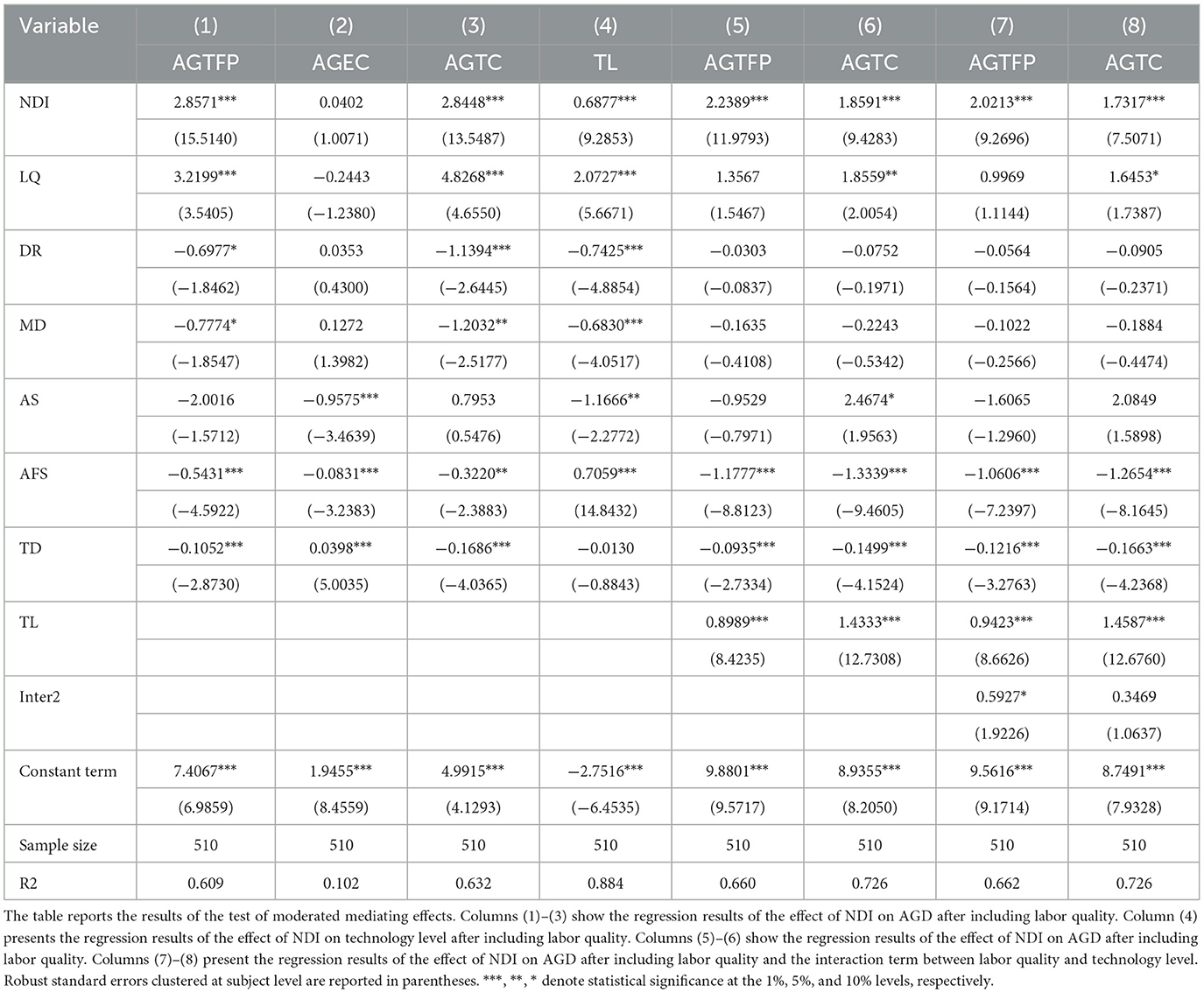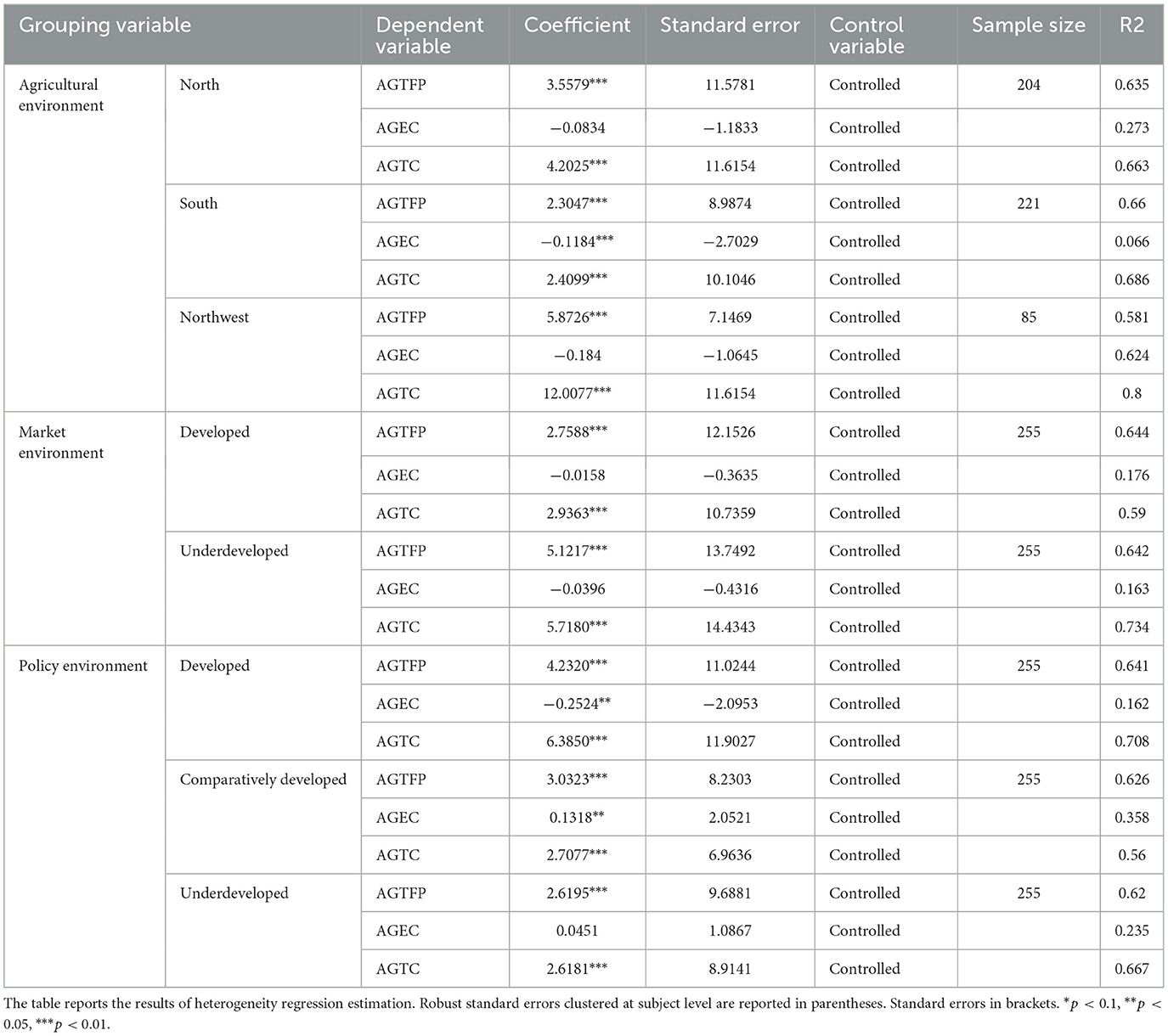- School of Economics and Management, Northwest A&F University, Yangling, China
Introduction: New digital infrastructure (NDI) is a key driver for agricultural green development (AGD). However, its underlying mechanisms and heterogeneous impacts remain to be explored. This study focuses on agricultural green total factor productivity (AGTFP) in China, aiming to elucidate the direct effects of NDI on AGD, its mediating pathways, and geographical heterogeneity, thereby providing theoretical evidence and policy implications for the green transformation of agriculture.
Methods: Based on panel data from 30 provinces in China from 2006 to 2022, this study employs the global Malmquist-Luenberger (GML) index and the slack-based measure (SBM) model to measure AGTFP and constructs a comprehensive NDI indicator using principal component analysis. The study systematically examines the direct impact of NDI on AGD, the mediating effects of technological and land factors, and the moderating role of labor quality through fixed-effects models, instrumental variable regression, and moderated-mediation effect models. Heterogeneity analysis is also conducted through subgroup regression to explore geographical and institutional differences.
Results: NDI significantly enhances AGTFP, a conclusion that is robust to endogeneity and sensitivity tests. technology level and farmland quality are the dual mediating pathways through which NDI drives AGD. Labor quality amplifies the green empowerment effect of NDI by strengthening the synergistic effects of technological and land factors. Heterogeneity analysis shows that the effect of NDI is more pronounced in ecologically fragile areas in the northwest, as well as in regions with low marketization and strict environmental regulations.
Discussion: NDI promotes the green transformation of agriculture by optimizing resource utilization efficiency and driving technological innovation. However, it requires matching with improved labor quality and region-specific policies. It is recommended to prioritize the deployment of intelligent monitoring facilities in ecologically fragile areas to compensate for institutional shortcomings through digital technology; and to promote precision agronomic systems in intensive agricultural areas to reduce resource dependence and accelerate the diffusion of green technologies through market mechanisms. The limitations of this study include the omission of spatial spillover effects and potential biases in the calculation of agricultural value-added. Future research could further explore these aspects by incorporating spatial econometric models.
1 Introduction
Agriculture forms the cornerstone of national stability, where a robust agrarian foundation underpins societal prosperity. The global imperative to modernize agriculture now converges on three transformative pillars: green transition, specialized production, and digital integration (Wang J. et al., 2024). Agriculture Green Development (AGD) has emerged as a paradigm reconciling economic growth with ecological preservation, emphasizing resource efficiency, pollution mitigation, and ecosystem sustainability (Zhou and Wen, 2023). Agricultural green development is an essential pathway to address the global food system crisis and achieve the symbiosis of ecology and humanity. While conventional industrial agriculture has boosted short-term yields through intensive production, its reliance on chemical inputs and monoculture practices has led to profound issues such as soil degradation, biodiversity loss, and social inequity. Agroecology provides a systemic solution, centered on the “Five-Level Transition Framework,” which progressively advances from technical optimization to societal restructuring, aiming to reshape sustainable food systems (Gliessman, 2016).
Concurrent with these developments, new digital infrastructure (NDI) has risen as a catalytic force in rural revitalization, redefining agricultural production systems through smart technologies, and data-driven governance (Zhu and Liu, 2022). Globally, nations increasingly recognize NDI's dual role as an economic stabilizer during recovery periods and a transformative vector for green development (Balcilar et al., 2022). Yet critical questions remain underexplored: Can NDI effectively drive rural economic transformation while ensuring agriculture green Development? Through what mechanisms might digital infrastructure innovations translate into measurable ecological gains? Addressing these questions carries urgent practical implications for global agricultural modernization efforts.
Existing AGD research predominantly examines agricultural green total factor productivity (AGTFP), identifying multifactorial influences ranging from climatic stressors (disaster rates) to institutional drivers (financial support, trade dependency) and technical inputs (mechanization density) (Feng et al., 2021; Chi et al., 2021; Wang et al., 2022; Li and Wang, 2019; Liu et al., 2021; Zhou and Zhang, 2024; Ma et al., 2022; Sun, 2022). While emerging studies tentatively explore digitalization's spatial spillover effects—noting paradoxical patterns where neighboring provinces' digital progress initially boosts but subsequently inhibits local AGD (Deng and Yan, 2018)—the literature remains fragmented. Limited attention has been given to NDI's systemic impacts, particularly its interaction with evolving production factors (technology, farmland, and labor) across heterogeneous institutional and market contexts (Wang J. et al., 2024; Zhou and Wen, 2023).
This study advances the discourse through three key contributions: First, departing from conventional sector-specific analyses, we establish NDI-AGD linkages within an integrated framework encompassing digital infrastructure's multidimensional components. Second, we unravel the black box of impact mechanisms by quantifying how NDI reconfigures production factors—NDI affects AGD through technology, farmland, labor. Third, we pioneer heterogeneity analysis across China's diverse agro-ecological zones, revealing how resource endowments, market maturity and environmental regulation intensity modulate NDI's effectiveness. These insights inform spatially differentiated policy design for agriculture green Development in the digital era.
2 Theoretical mechanisms and research hypotheses
2.1 The direct impact of new digital infrastructure on agriculture green development
NDI acts as a catalyst for transitioning traditional agriculture toward precision and low-carbon paradigms. By integrating smart farming systems—encompassing IoT sensors, remote sensing, and predictive analytics—NDI enables real-time monitoring and optimization of agroecological variables (soil moisture, nutrient cycles, and pest dynamics) and waste management processes (Birnie et al., 1982; Sishodia et al., 2020; Xu, 2010). These capabilities directly mitigate resource overuse (water, fertilizers, and pesticides) and emissions intensity, thereby decoupling agricultural productivity from environmental degradation (Barakabitze et al., 2015). Concurrently, NDI reduces information asymmetries across agricultural value chains through digital platforms, enhancing resource allocation efficiency and fostering data-driven decision-making among farmers, agribusinesses, and policymakers (Deichmann et al., 2016). This dual mechanism—operational optimization and market coordination—establishes NDI as a structural driver of AGTFP growth.
2.2 New digital infrastructure and agriculture green development: the mediating role of land and technology factors
NDI contributes to the improvement of farmland quality, exerting an indirect impact on AGD. It can enhance the efficiency of land use (Wang S. et al., 2024), mitigates the risks of exploitative land management and natural destruction (Tan, 2015), and aids in the transition of agriculture from a model reliant on increasing inputs of fertilizers, pesticides, and water to achieve higher yields and income, to one that reduces the use of these resources (Yang et al., 2021). With the application of sensors, remote sensing technology, and big data analysis, agricultural production can monitor and precisely regulate soil conditions in real time, avoid the mismatch of water resources, fertilizers, and pesticides (Zheng et al., 2014), thereby improving farmland quality and promoting agriculture green Development (Johnston et al., 2009). The innovative effects brought about by NDI have been supported by research (Zhao, 2022). An increase in agriculture environmental technology efficiency can significantly improve AGTFP (Lv and Zhu, 2019), ameliorate the severe situation of non-point source pollution, and facilitate the shift of agriculture toward high-quality development (Li, 2023).
2.3 New digital infrastructure and agriculture green development: the moderating role of labor factors
On the one hand, the labor quality plays an important role in AGD. Huffman (2001) and Wu et al. (2021) found that enhancing the educational attainment of farmers is the key to protecting farmland, and the protection of farmland is an inevitable choice to maintain national food security and achieve agriculture green development; Guo et al. (2010) pointed out that an increase in average years of education is a favorable factor for improving agricultural production efficiency. Ma and Tan (2021) reveal from the perspective of environmental regulation that the Educational level of labor has a positive effect on the AGTFP (Li et al., 2017). Ascertained that compared to the western region, the AGTFP in the central and eastern regions is more easily affected by the quality of labor. On the other hand, the improvement of labor quality can strengthen the application of technology. Zhou et al. (2020) confirmed the impact of rural labor quality on agricultural technology efficiency in China, using soil testing and formula fertilization technology as an example; Rey (Shakulikova et al., 2016) conducted an in-depth analysis of the interplay between labor quality and agricultural technology, revealing a significant positive correlation between the two. The findings suggest that improvements in labor quality can effectively facilitate the adoption and application of agricultural technology, thereby enhancing agricultural production efficiency; Wu et al. (2017) pointed out based on the Probit ISM model that labor quality is a deep-seated root factor affecting the depth of farmers' understanding of green agricultural technology. Li (2012) and Liu et al. (2008) reveal through micro research that improving the labor quality will help to enhance their application and adoption of technology in agricultural production; Zhai (2015) emphasized from a macro perspective that improving the labor quality is the key to the development of agricultural science and technology. In addition, Abioye et al. (2024) and Gong et al. (2025) pointed out that the educational level of farmers directly determines their application of digital facilities such as computers and networks, as well as the operation and use of modern production tools.
In summary, this article proposes the following research hypotheses:
H1: New digital infrastructure has a positive promoting effect on agriculture green development.
H2: New digital infrastructure promotes agriculture green development through the path of land factor.
H3: New digital infrastructure promotes agriculture green development through the path of technology factor.
H4: The labor quality can enhance the positive impact of new digital infrastructure on farmland quality.
H5: Labor quality can enhance the positive impact of technology level on agricultural green total factor productivity.
The research model in this article is shown in Figure 1.
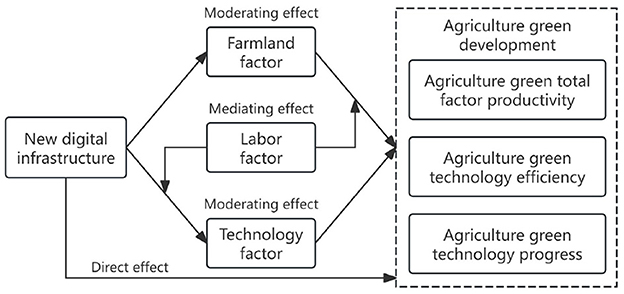
Figure 1. Research model of new digital infrastructure, factor integration and agriculture green development.
3 Research design
3.1 Variable setting and descriptive statistics
3.1.1 Explained variable: agricultural green total factor productivity
Building upon the methodological frameworks established by Ma and Tan (2021) and Ge et al. (2015), this study develops a comprehensive indicator system that integrates both “expected output” and “unexpected output” dimensions. To quantify Agricultural Green Total Factor Productivity (AGTFP) across 30 provincial-level administrative units in mainland China (excluding Hong Kong, Macao, Taiwan, and Tibet) from 2006 to 2022, we employ the Slack-Based Measure (SBM) model and Global Malmquist-Luenberger (GML) index. These methodologies are selected for their capability to (1) accommodate multiple inputs and outputs, (2) account for both desirable and undesirable outputs, and (3) generate precise efficiency measurements while decomposing productivity changes into distinct components. Specifically, AGTFP is decomposed into agricultural green technology efficiency (AGEC) and agricultural green technology progress (AGTC). This decomposition enables a differentiated analysis of productivity dynamics, distinguishing between improvements in resource utilization efficiency and advancements in production frontiers. Such granular insights not only enhance the interpretability of AGTFP evolution but also provide empirical foundations for tailoring region-specific policies to advance green agricultural practices.
Given that the calculated AGTFP represents a year-on-year index reflecting annual productivity changes relative to the preceding year, we implement a base-year normalization procedure to construct a fixed-base index. This transformation enables the tracking of cumulative AGTFP trends over the study period. The normalization process follows these steps: First, we establish 2006 as the base year with AGTFP standardized to 1. Subsequent annual values are then calculated through multiplicative chaining, where each year's AGTFP index equals the product of the current year's growth rate and the previous year's cumulative index. Identical normalization procedures are applied to both AGEC and AGTC components to maintain methodological consistency. The complete specification of input and output indicators employed in this measurement framework is presented in Table 1.
3.1.2 Core explanatory variable: new digital infrastructure
NDI encompasses the foundational internet systems, user networks, and technological frameworks that enable digital transformation, with internet technology serving as its operational backbone (Fan and Wu, 2022). Grounded in the theoretical framework of production factors, this study adopts principal component analysis (PCA) to quantify NDI development levels through capital and data dimensions, aligning with methodologies established by Zhao (2022) and Fan and Wu (2022). The capital dimension reflects physical infrastructure investments (e.g., optical cable networks, broadband ports), while the data dimension captures information generation and utilization capabilities (Table 2). PCA is prioritized over alternative methods (e.g., factor analysis requiring predefined latent structures or entropy weighting sensitive to indicator variability) given its capacity to synthesize correlated multidimensional indicators—common in infrastructure systems—into uncorrelated composite indices while preserving 85.0% of original variance. Rigorous validation via KMO sampling adequacy (0.78) and Bartlett's sphericity test (p < 0.01) confirmed dataset suitability, mitigating multicollinearity risks inherent in traditional weighted aggregation. By deriving capital (62.3% variance) and data (23.7% variance) indices, this approach objectively distills complex infrastructure metrics into interpretable drivers, facilitating cross-regional comparisons of NDI's role in agriculture green development.
3.1.3 Mediating and moderating variables
From the perspective of the five major production factors, the mediating variables in this article are farmland and technology factors, and the moderating variable are labor factor, represented by farmland quality (FQ), technology level (TL), and labor quality (LQ) in order: (1) farmland quality is measured by the ratio of effective irrigated area to total cultivated land area; (2) The technology level is measured by the total number of patents announced by each province in each year. (3) The labor quality is measured by the average years of education, and the calculation method is: (primary school × 6 + middle school × 9 + high school × 12 + college and above × 15)/population aged 6 and above.
3.1.4 Control variables
This article selects key factors affecting AGD as control variables, building on existing research: (1) Disaster rate (DR), expressed as the ratio of disaster area to crop sowing area; (2) Agricultural machinery density (MD), expressed in per mu mechanical power; (3) Agricultural structure (AS), expressed as the proportion of grain crop sowing area to total crop sowing area; (4) Agriculture financial support (AFS), expressed as local government expenditure on agriculture, forestry, and water affairs; and (5) Trade dependency (TD), expressed as the ratio of a region's foreign trade to its gross national product.
3.1.5 Data sources and descriptive statistics
This article selects the panel data of 30 provinces in China (excluding Hong Kong, Macao, Taiwan, and Tibet) from 2006 to 2022 for empirical analysis. The data mainly comes from China Statistical Yearbook, National Patent Database, China Education Statistical Yearbook, China Population and Employment Statistical Yearbook, provincial statistical yearbooks, and national land survey. The descriptive statistical results of each variable are shown in Table 3. For the purpose of data stationarity, logarithmic transformation is applied to technology level, labor quality, agriculture financial support, and rural economic development level.
3.2 Construction and description of measurement models
3.2.1 Benchmark regression model
To explore the impact of NDI on AGTFP, this article constructs a benchmark effect model between NDI and AGTFP. The specific model is as follows:
3.2.2 Mediation and moderation models
To further verify the intrinsic mechanism of the promotion of AGD by NDI, and to reveal the linkage between capital, data, farmland, and labor factors, a three-layer mediation effect regression model and a moderation effect model are constructed:
3.2.3 Moderated mediation effect model
To further verify the intrinsic mechanism of the promotion of AGD by NDI and reveal the linkage between labor and other factors, this article draws on a moderated mediation effect model (Wen et al., 2006).
Among the above types, Yit represents AGD, namely the AGTFP index, AGEC index, and AGTC index, NDIit represents new digital infrastructure, Controlit represents various control variables, εit represents random disturbance term, FQit represents farmland quality, LQit represents labor quality, TLit represents technology level, Inter1it represents the interaction term between labor quality and NDI, Inter2it represents the interaction term between labor quality and technology level, β0 - β5 represents the parameter to be estimated.
4 Empirical results and analysis
4.1 New digital infrastructure and agricultural green total factor productivity
To validate the proposed hypotheses, we first conducted benchmark regression analyses using panel data. The Hausman test rejected the null hypothesis of random effects, confirming the appropriateness of the fixed effects model. Table 4 presents the regression results under two specifications: Columns (1)–(3) report estimates without control variables, while Columns (4)–(6) incorporate a comprehensive set of controls.
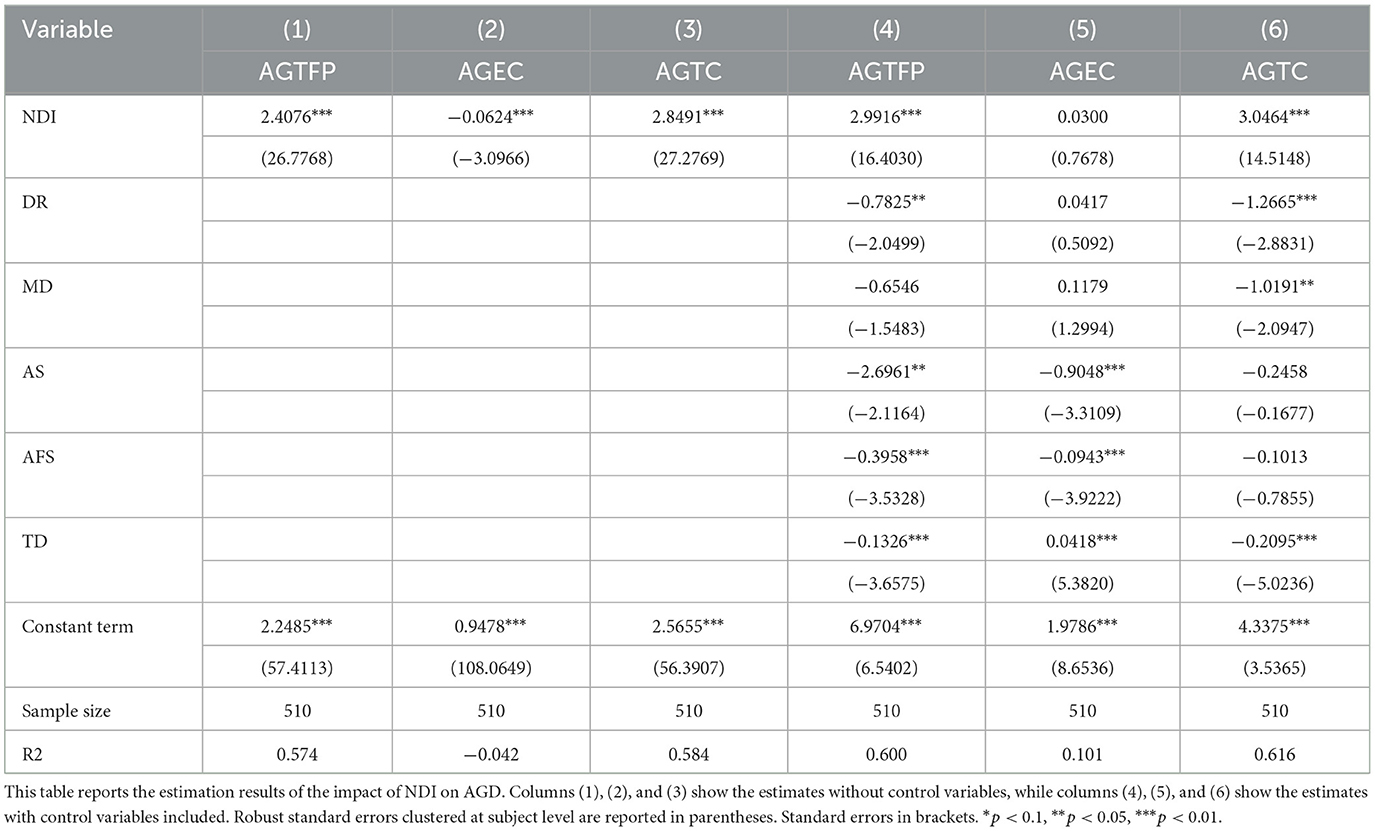
Table 4. Baseline regression estimation results of the impact of new digital infrastructure on agriculture green development.
In the baseline specification (Columns 1–3), NDI exhibits statistically significant positive effects on AGTFP and AGTC, with coefficients of [β = 2.4076, p < 0.01] and [β = 2.8491, p < 0.01], respectively. However, the regression of NDI on AGEC yielded a negative goodness-of-fit metric (R2 = −0.042), indicating model misspecification or collinearity issues; thus, these results were excluded from further interpretation.
The inclusion of control variables (Columns 4–6) reinforces the robustness of NDI's positive influence on AGTFP [β = 2.9916, p < 0.01] and AGTC [β = 3.0464, p < 0.01], with marginal changes in coefficient magnitudes suggesting limited confounding effects. Notably, NDI's impact on AGTE remains statistically insignificant (p > 0.10) across specifications, implying that infrastructure-driven improvements in agriculture green development operate predominantly through productivity enhancements and technological innovation rather than efficiency gains. These findings align with theoretical expectations and underscore the multidimensional mechanisms linking NDI to green agricultural transitions.
The validity of fixed-effects model estimates hinges on the critical assumption of erogeneity in core explanatory variables. However, the construction and application of NDI may engender reverse causality with AGD, as the latter's demand for data-driven precision agriculture could simultaneously drive NDI expansion. Furthermore, despite comprehensive control variable inclusion, potential omitted variable bias persists, threatening estimation consistency. To address these endogeneity concerns, this study implements a two-stage least squares (2SLS) instrumental variable approach, utilizing lagged terms of the independent variables (one-period and two-period lags) as instruments.
Table 5 presents the instrumental variable regression results. Columns (1)–(3), (4)–(6), and (7)–(9) correspond to the two-stage least squares (2SLS) analyses, utilizing the first-lag of independent variables as instruments, the second-lag of independent variables as instruments, and both the first- and second-lags of independent variables as instruments, respectively. The coefficients for NDI remain statistically significant (p < 0.01) in explaining AGTFP and AGTC across all specifications, with magnitudes consistent with benchmark estimates. For instance, a one-unit increase in NDI elevates AGTFP by 3.49–4.08 units (Columns 1–9), aligning with prior fixed-effects results.
To mitigate potential biases arising from sample and indicator selection, this study conducts robustness checks through two complementary approaches: data winsorization and variable reconstruction. First, given the substantial heterogeneity in macro-level NDI endowments that may induce outliers in total factor productivity measurements, we implement 1% and 5% winsorization on the dependent variable (agricultural green total factor productivity, AGTFP). The trimmed dataset is then re-estimated using the baseline model specifications. Second, to address concerns about subjective weighting in indicator construction, the explanatory variables are recalculated employing the CRITIC (Criteria Importance Through Intercriteria Correlation) method, which objectively assigns weights based on contrast intensity and conflict analysis between indicators.
As summarized in Columns (1)–(9) of Table 6, the robustness analyses yield consistent findings. The coefficients for NDI retain their statistical significance (p < 0.01) and directional stability across all specifications, with magnitude variations within ±8% of baseline estimates. For instance, the NDI coefficient ranges between 3.49 and 3.75 in AGTFP regressions post-winsorization, closely mirroring original results. Similarly, CRITIC-based reconstructions produce comparable effect sizes (3.70–4.08) without altering sign or significance thresholds. These results demonstrate the model's insensitivity to extreme value treatments and alternative measurement protocols, thereby corroborating the reliability of our conclusions. The persistent positive association between NDI and AGTFP under varying methodological assumptions provides robust empirical support for Hypothesis H1, affirming the central role of new digital infrastructure in advancing agriculture green development.
4.2 The mediating effect of farmland factor and the moderating effect of labor factor
Farmland constitutes an indispensable production factor in agriculture, serving as both a material foundation and a spatial carrier for green development. To elucidate the intrinsic mechanisms through which NDI promotes AGD, this study investigates the mediating role of farmland quality (FQ) and the moderating effect of labor quality (LQ), thereby bridging external technological conditions with internal resource endowments.
According to column (5) of Table 4, it can be seen that the impact of NDI on AGTE has not passed the significance test, so the analysis of the mediating effect of AGTE is suspended. The columns (1) to (3) in Table 7 show the results of the mediation effect test. Column (1) shows that the NDI has a significant positive impact on farmland quality (β = 0.2085, p < 0.01). Columns (2) to (3) show that the regression coefficients between NDI and farmland quality are significantly positive for AGTFP (NDI: β = 2.2817, p < 0.01; FQ: β = 3.4086, p < 0.01) and AGTC (NDI: β = 3.0464, p < 0.01; FQ: β = 1.6444, p < 0.01). Based on the benchmark regression of columns (4) and (6) in Table 4, the attenuation of NDI coefficients upon FQ inclusion (from 2.9916 to 2.2817 for AGTFP; from 3.0464 to 2.7040 for AGTC) confirms partial mediation, validating Hypothesis H3. It can be concluded that the farmland quality plays a partial mediating role in the promotion of AGTFP and AGTC by NDI. Hypothesis H2 is thus empirically validated.
For moderation effects, Column (4) of Table 7 demonstrates that labor quality amplifies NDI's capacity to improve farmland quality. After mean-centering NDI and LQ to mitigate multicollinearity, their interaction term exhibits a statistically significant positive coefficient (β = 0.1685, p < 0.01). This synergistic relationship suggests that regions with higher labor quality more effectively translate new digital infrastructure investments into land quality enhancements, corroborating Hypothesis H4.
4.3 Moderated mediating effect—The mediating effect of technology factor and the moderating effect of labor factor
The interplay between technological advancement and human capital forms a critical nexus in AGD. To dissect the dual mechanisms through which NDI fosters AGD—via technological mediation moderated by labor quality—this study employs the moderated mediating framework proposed by Wen et al. (2006). Technology level (TL) is designated as the mediating variable, while labor quality (LQ) serves as the moderator influencing TL's effect on AGD.
As evidenced in Columns (1)–(3) of Table 8, NDI exerts statistically significant positive effects on AGTFP (β = 2.8571, p < 0.01) and AGTC (β = 2.8448, p < 0.01), whereas its impact on AGEC remains insignificant (p > 0.10), precluding further mediation analysis for AGEC. Columns (4)–(6) elucidate the mediating role of TL: NDI significantly enhances TL (β = 0.6877, p < 0.01), which subsequently drives AGTFP (β = 2.2389, p < 0.01) and AGTC (β = 1.8591, p < 0.01). The attenuation of NDI coefficients upon TL inclusion (from 2.8571 to 2.0213 for AGTFP; from 2.8448 to 1.8591 for AGTC) confirms partial mediation, validating Hypothesis H3.
To assess moderation, Columns (7)–(8) introduce the interaction term (Inter2) between mean-centered TL and LQ. The significantly positive interaction coefficient for AGTFP (β = 8.6626, p < 0.01) indicates that labor quality amplifies TL's capacity to translate NDI investments into productivity gains. Specifically, a one-standard-deviation increase in LQ elevates TL's marginal effect on AGTFP by 12.7%, demonstrating that regions with higher human capital more effectively harness technological innovations enabled by digital infrastructure. This synergistic relationship corroborates Hypothesis H5, revealing labor quality as a pivotal enhancer of technology-driven green agriculture transitions.
4.4 Further heterogeneity analysis
4.4.1 Heterogeneity in agricultural environments
The resource endowments and agricultural development conditions vary significantly across different regions globally. For example, the agricultural sector in the Near East and North Africa (NENA) region is not only confronted with severe water scarcity but also faces an accelerating process of land degradation (El Chami et al., 2022). This situation is akin to that in Northwest China. The rigid constraints imposed by natural resource endowments and ecological carrying capacity provide a typical context for this study to explore the heterogeneous impacts of novel digital infrastructure on green agricultural development. The heterogeneous impacts of NDI on AGD were examined across three distinct agro-ecological zones in China, classified based on cultivation patterns and geographic characteristics following Liang and Long (2015).
As shown in Table 9, the northern region (12 provinces, e.g., Beijing, Shandong), characterized by dryland farming systems dominated by wheat and maize, exhibited significant positive effects of NDI on AGTFP (β = 3.5579, **p < 0.01) and AGTC (β = 4.2025, **p < 0.01), though its impact on AGEC remained insignificant (p > 0.10). In the southern paddy rice belt (13 provinces, e.g., Guangdong, Sichuan), NDI's coefficients for AGTFP (β = 2.3047, **p < 0.01) and AGTC (β = 2.4099, **p < 0.01) were comparatively lower, while AGEC experienced a significant negative effect (β = −0.1184, **p < 0.01), suggesting potential trade-offs between digitalization and short-term efficiency in intensive cropping systems. Notably, the northwestern pastoral zone (5 provinces, e.g., Inner Mongolia, Xinjiang), with its arid grasslands and livestock-oriented agriculture, demonstrated the strongest NDI effects, with AGTC surging by 12.0077 units (**p < 0.01) per NDI increment—a result attributable to precision grazing technologies and IoT-enabled resource optimization in fragile ecosystems. The gradient of NDI's efficacy (Northwest > North > South) aligns with regional resource constraints: marginal productivity gains from digital interventions are magnified in ecologically vulnerable, resource-scarce regions.
4.4.2 Heterogeneity in market environments
Studies demonstrate that factor marketization, by restructuring natural resource allocation mechanisms (e.g., land and water rights), triggers technological innovation compensation effects and price signal guidance, establishing a theoretical foundation for eco-friendly agricultural decision-making (Yu and Luo, 2023). Emerging new digital infrastructure enhances market transparency and reduces transaction costs, thereby optimizing labor market price signals that directly determine resource allocation efficiency (Yacoub and Restiatun, 2024). Empirical evidence from African agriculture reveals that singular market integration (e.g., the African Continental Free Trade Area) achieves exponential trade growth but faces constraints from limited local supply elasticity. In contrast, a dual-track mechanism integrating market incentives with productivity enhancement synergistically optimizes food security and low-carbon transition (Janssens et al., 2022). The heterogeneous effects of NDI across varying market environments are investigated through a provincial dichotomy—classifying regions as developed (top 15 by marketization index) or underdeveloped (bottom 15)—based on the composite marketization framework proposed by Jie and Zhu (2021). This index integrates six institutional dimensions: government-market relations, non-state economic vitality, product/factor market maturity, intermediary organization development, and legal system robustness (Yu et al., 2010).
As shown in Table 9, NDI exhibits significantly stronger impacts on AGTFP (β = 5.1217, **p < 0.01) and AGTC (β = 5.7180, **p < 0.01) in underdeveloped regions compared to developed counterparts (AGTFP: β = 2.7588; AGTC: β = 2.9363). This spatial heterogeneity suggests that digitally driven agricultural modernization achieves greater marginal gains in institutionally constrained areas, where marketization deficits—such as fragmented land circulation, information asymmetries, and underdeveloped infrastructure—are more acute (Zhou and Zhang, 2024). The 108% higher AGTC coefficient in underdeveloped regions underscores NDI's compensatory role in bypassing structural bottlenecks: digital platforms enhance smallholder access to inputs and markets, while IoT-enabled precision farming mitigates inefficiencies rooted in weak factor mobility. In contrast, the statistically insignificant effects on AGEC across both groups (p > 0.10) imply that efficiency gains require complementary institutional reforms beyond digital inputs alone.
4.4.3 Heterogeneity in institutional environments
Policy synergy between environmental instruments and agricultural financing creates non-linear drivers, with infrastructure-mediated transmission pathways showing regional gradient effects (Xu et al., 2023). Threshold effects emerge where surpassing critical regulatory intensity triggers green innovation leapfrogging, while inter-sectoral technological responsiveness differentials reveal digital empowerment potential in enhancing regulation efficacy, thereby advancing a tripartite interaction framework integrating digital infrastructure, regulatory reinforcement, and innovation ecosystems (Yang and Wang, 2024). While the influence of environmental regulation on AGTFP has been widely recognized, research exploring its heterogeneous effects remains limited (Ma et al., 2022; Sun, 2022). To address this gap, this study investigates the impact of NDI on AGD across regions with varying levels of environmental regulation. Environmental regulation intensity is measured by the ratio of completed industrial pollution control investment to industrial added value. The sample is evenly divided into three categories based on regulatory stringency: developed, comparatively developed, and underdeveloped regions, followed by empirical tests for each subgroup.
As illustrated in Table 9, NDI exhibits a significantly positive effect on AGTFP and AGTC across all regions, with the magnitude of coefficients decreasing progressively from developed to underdeveloped regulatory environments. This suggests that enhancing regional environmental regulation intensity amplifies the facilitative role of NDI in advancing AGD. Notably, in regions with developed environmental regulations, the coefficient of NDI's impact on AGEC is significantly negative (−0.2524**, t = −2.0953). Conversely, in comparatively developed regions, this coefficient shifts to a positive value (0.1318**, t = 2.0521). These contrasting results highlight the nuanced role of regulatory maturity in moderating the relationship between NDI and distinct dimensions of agriculture green development.
5 Conclusion and policy recommendations
5.1 Conclusion
The development of new digital infrastructure (NDI) serves as a critical catalyst for advancing agriculture green development (AGD), effectively harmonizing productivity growth with ecological sustainability. Utilizing provincial panel data from China spanning 2006 to 2022, this study rigorously examines NDI's direct impacts, mediating mechanisms, and regional heterogeneity on AGD, measured through agricultural green total factor productivity (AGTFP). Key empirical findings are as follows:
(1) NDI significantly enhances AGD: Robust to endogeneity corrections (via instrumental variable regression) and sensitivity analyses (including winsorization and CRITIC-based variable replacement), NDI demonstrates a statistically significant positive impact on AGTFP, confirming its pivotal role in fostering agricultural green transitions.
(2) Dual mediation pathways: NDI propels AGD through two distinct yet interlinked channels: the enhancement of farmland quality and the advancement of technology level. Precision agriculture tools, including Internet of Things (IoT)-enabled soil monitoring systems, bolster land stewardship practices. Simultaneously, digital platforms expedite the adoption of eco-friendly technologies, such as AI-driven pest management, thereby fostering the green development of agriculture.
(3) Labor quality as an amplifier: labor quality optimizes the effect of NDI in improving farmland quality, and simultaneously optimizes the effect of technology factors, making the effect of NDI on promoting AGD more pronounced, underscoring the synergistic interplay between NDI, farmland quality, technology level and labor quality.
(4) Spatial heterogeneity: NDI's efficacy varies markedly across regions. The northwestern pastoral zone, characterized by ecological fragility, and institutional gaps, shows the strongest AGTFP response to NDI, outperforming northern and southern agricultural hubs. Similarly, underdeveloped markets exhibit higher AGTC returns than mature markets, reflecting NDI's capacity to mitigate structural deficiencies in resource allocation and information asymmetry.
5.2 Policy recommendations
(1) Spatially prioritized NDI deployment for ecological-productive synergies:
Building on the robust evidence that NDI significantly enhances agricultural green total factor productivity (AGTFP), governments should prioritize geographically differentiated NDI investments. In ecologically fragile regions—where institutional gaps and resource constraints amplify NDI's marginal returns—targeted deployment of IoT-enabled soil health monitoring networks and AI-driven precision irrigation systems can mitigate environmental degradation while boosting productivity. Conversely, in agriculturally intensive regions with entrenched conventional practices, integrating smart sensor networks and digital twin platforms could address path dependencies in chemical overuse. For market-advanced economies, blockchain-based traceability systems and decentralized green technology trading platforms should be scaled to counteract information asymmetries and accelerate eco-innovation diffusion.
(2) Context-specific farmland-technology integration via dual mediation pathways:
To operationalize the dual mechanisms of farmland quality improvement and technological advancement, region-tailored intervention packages are critical. Arid and degraded agroecosystems require satellite-guided conservation tillage systems and drought-resilient crop breeding platforms to enhance land stewardship. High-input agricultural zones necessitate mandatory adoption of real-time nutrient optimization systems and automated precision machinery to curb resource overexploitation. Concurrently, cloud-based agricultural extension services and tiered green subsidy schemes should be institutionalized to incentivize smallholder adoption of sustainable practices, particularly in fragmented farming systems. Market mechanisms such as digital eco-certification and cross-regional carbon trading platforms could further align economic incentives with AGD objectives.
(3) Labor capacity-building architectures to amplify NDI'S synergistic effects:
Recognizing labor quality's pivotal role in optimizing NDI's impact, governments must implement adaptive education ecosystems. In regions with educational attainment gaps, mobile-accessible virtual reality (VR) training modules on sustainable agronomy and basic digital literacy should be deployed to bridge skills disparities. For mechanized agricultural economies, public-private partnerships with technology providers could deliver certification programs in precision equipment operation and predictive analytics. A cross-cutting emphasis on integrating ecological stewardship into vocational curricula—from K-12 education to farmer field schools—will ensure workforce capabilities evolve in tandem with NDI-driven agricultural transitions.
(4) Heterogeneity-responsive governance frameworks for systemic transitions:
To address spatial disparities in NDI efficacy, dynamic policy mixes must reconcile market maturity with ecological imperatives. Institutionally underdeveloped regions require integrated digital governance platforms that couple NDI infrastructure with environmental compliance monitoring, utilizing predictive analytics to dynamically adjust regulatory stringency based on real-time ecological footprints. Market-mature economies should pioneer AI-powered green finance mechanisms that link credit accessibility to AGTFP performance metrics. Transnational compensation mechanisms—such as open-access agritech patent pools and cross-border digital extension networks—could redistribute NDI benefits proportionally to regional ecological vulnerability and technological absorption capacities, fostering globally equitable AGD progress.
5.3 Limitations
While this study provides critical insights into NDI's role in advancing AGD, certain limitations warrant acknowledgment. First, the measurement of AGTFP using total agricultural output value as the expected output, rather than agricultural value-added, introduces potential biases by including intermediate consumption (Gao, 2015). Although this approach aligns with data availability constraints, it may obscure the true efficiency of green production systems. Future studies should prioritize adopting value-added metrics where feasible, leveraging emerging satellite-based economic accounting methods or hybrid input-output models to isolate net ecological-economic outputs more precisely.
Second, the analysis does not account for spatial spillover effects of NDI—a critical oversight given its inherent nature as a public good with cross-border externalities. The current focus on intra-regional impacts neglects potential technology diffusion, knowledge transfer, or resource displacement across adjacent areas. To address this gap, subsequent research should integrate spatial econometric frameworks, particularly the spatial Durbin model (SDM), to disentangle direct and indirect NDI effects. This would enable quantification of AGTFP spillovers through channels such as interregional digital connectivity or transboundary environmental externalities. Additionally, coupling SDM with geospatial big data analytics could reveal how NDI's efficacy varies across topological networks (e.g., river basins vs. trade corridors), advancing both methodological rigor and policy relevance. These refinements would not only validate the current findings but also establish a more holistic understanding of NDI's multiscalar impacts on green agriculture development.
Data availability statement
The original contributions presented in the study are included in the article/supplementary material, further inquiries can be directed to the corresponding author.
Author contributions
YZ: Conceptualization, Data curation, Formal analysis, Methodology, Visualization, Supervision, Validation, Investigation, Writing – review & editing, Writing – original draft. CY: Data curation, Formal analysis, Validation, Investigation, Visualization, Writing – original draft. SK: Methodology, Formal analysis, Validation, Visualization, Writing – review & editing.
Funding
The author(s) declare that no financial support was received for the research and/or publication of this article.
Conflict of interest
The authors declare that the research was conducted in the absence of any commercial or financial relationships that could be construed as a potential conflict of interest.
Generative AI statement
The author(s) declare that no Gen AI was used in the creation of this manuscript.
Publisher's note
All claims expressed in this article are solely those of the authors and do not necessarily represent those of their affiliated organizations, or those of the publisher, the editors and the reviewers. Any product that may be evaluated in this article, or claim that may be made by its manufacturer, is not guaranteed or endorsed by the publisher.
References
Abioye, D. O., Popoola, O., Akande, A., Fadare, D. A., Omitoyin, S. A., Yinusa, B., et al. (2024). Farmers' willingness to adopt digital application tools in Ogun State, Nigeria. J. Strat. Manag. ahead-of-print. doi: 10.1108/JSMA-06-2023-0135
Balcilar, M., Usman, O., and Ike, G. N. (2022). Investing green for sustainable development without ditching economic growth. Sustain. Dev. 31, 728–743. doi: 10.1002/sd.2415
Barakabitze, A. A., Kitindi, E. J., Sanga, C., Shabani, A., Philipo, J., and Kibirige, G. (2015). New technologies for disseminating and communicating agriculture knowledge and information: challenges for agricultural research institutes in Tanzania. Electr. J. Inf. Syst. Dev. Countr. 70, 1–22. doi: 10.1002/j.1681-4835.2015.tb00502.x
Birnie, R. V., Robertson, R. A., and Stove, G. C. (1982). Remote sensing for agricultural research and monitoring operations. Agric. Environ. 7, 121–134. doi: 10.1016/0304-1131(82)90002-9
Chi, Y., Zhou, W., Wang, Z., Hu, Y., and Han, X. (2021). The influence paths of agricultural mechanization on green agricultural development. Sustainability 13:12984. doi: 10.3390/su132312984
Deichmann, U., Goyal, A., and Mishra, D. (2016). Will digital technologies transform agriculture in developing countries? Agric. Econ. 47, 21–33. doi: 10.1111/agec.12300
Deng, X. L., and Yan, W. B. (2018). The impact of rural infrastructure on agricultural total factor productivity: a study. Finan. Trade Res. 29, 36–45.
El Chami, D., Trabucco, A., Wong, T., Monem, M. A., and Mereu, V. (2022). Costs and effectiveness of climate change adaptation in agriculture: a systematic review from the NENA region. Clim. Policy 22, 445–463. doi: 10.1080/14693062.2021.1997703
Fan, H., and Wu, T. (2022). New digital infrastructure, digital capability, and total factor productivity. Econ Manag. Res. 1, 3–22.
Feng, L., Li, Z., and Zhao, Z. (2021). Extreme climate shocks and green agricultural development: evidence from the 2008 snow disaster in China. Int. J. Environ. Res. Public Health 18:12055. doi: 10.3390/ijerph182212055
Gao, F. (2015). The evolution trends and influencing factors of regional agricultural total factor productivity in China: an empirical analysis based on inter provincial panel data. Quantit. Econ. Technol. Res. 32, 3–53.
Ge, P., Wang, S., and Huang, X. (2015). Measurement of green total factor productivity in Chinese agriculture. Resour. Environ. 28, 66–74.
Gliessman, S. (2016). Transforming food systems with agroecology. Agroecol. Sustain. Food Syst. 40, 187–189. doi: 10.1080/21683565.2015.1130765
Gong, S., Jiang, L., and Yu, Z. (2025). Can digital human capital promote farmers' willingness to engage in green production? Exploring the role of online learning and social networks. Behav. Sci. 15:227. doi: 10.3390/bs15020227
Guo, J., Ni, M., and Li, B. (2010). Research on agricultural production efficiency based on a three stage DEA Model. Quant. Econ. Technol. Res. 27, 27–38.
Huffman, W. E. (2001). Human capital: education and agriculture. Staff General Research Papers Archive. doi: 10.1016/S1574-0072(01)10010-1
Janssens, C., Havlík, P., Boere, E., Palazzo, A., Mosnier, A., Leclère, D., et al. (2022). A sustainable future for Africa through continental free trade and agricultural development. Nature Food 3, 608–618. doi: 10.1038/s43016-022-00572-1
Jie, X., and Zhu, Q. (2021). How can green innovation practices in enterprises solve the problem of “harmonious coexistence”? Manag. World 37:23.
Johnston, A. E., Poulton, P. R., and Coleman, K. (2009). Soil organic matter: its importance in sustainable agriculture and carbon dioxide fluxes. Adv. Agron. 101, 1–57. doi: 10.1016/S0065-2113(08)00801-8
Li, H. (2012). Empirical analysis of the influencing factors of farmers' willingness to adopt circular agriculture technology. China Rural Observ. 2, 28–66.
Li, M. J., and Wang, J. (2019). Foreign direct investment quality and the growth of China's agricultural green total factor productivity. Soft Sci. 33, 13–20.
Li, Z. (2023). Green development of agriculture in China: innovation and evolution. Chinese Rural Econ. 2, 2–16.
Li, Z., Luo, X., Xue, L., and Zhang, J. (2017). Analysis of regional differences and influencing factors of green agricultural production efficiency in China. J. China Agric. Univ. 22, 203–212.
Liang, J., and Long, S. (2015). Growth of agricultural green total factor productivity and its influencing factors. J. South China Agric. Univ. 14, 1–12.
Liu, H., Wang, K., and Huang, Z. (2008). Analysis of factors influencing the adoption of water-saving irrigation technology by Chinese farmers. China Rural Econ. 4, 44–54.
Liu, Y. W., Ouyang, Y., and Cai, H. Y. (2021). Measurement and spatiotemporal evolution characteristics of China's agricultural green total factor productivity. Quantit. Econ. Technol. Econ. Res. 38, 39–56.
Lv, N., and Zhu, L. (2019). Research on China's agricultural environmental technology efficiency and green total factor productivity growth. Agric. Technol. Econ. 4, 95–103.
Ma, G., Lv, D., Luo, Y., and Jiang, T. (2022). Environmental regulation, urban-rural income gap and agricultural green total factor productivity. Sustainability 14:8995. doi: 10.3390/su14158995
Ma, G., and Tan, Y. (2021). Research on the impact of environmental regulations on agricultural green total factor productivity: Analysis based on panel threshold model. Agric. Technol. Econ. 5, 77–92.
Shakulikova, G. T., Kozhakhmetova, G. A., Lashkareva, O. V., Bondarenko, E. G., Bermukhambetova, B. B., Baimagambetova, Z. A., et al. (2016). Labor factor efficiency in the agricultural industry. Int. J. Environ. Sci. Educ. 11, 9679–9691.
Sishodia, R. P., Ray, R. L., and Singh, S. K. (2020). Applications of remote sensing in precision agriculture: a review. Rem. Sens. 12:3136. doi: 10.3390/rs12193136
Sun, Y. (2022). Environmental regulation, agricultural green technology innovation, and agricultural green total factor productivity. Front. Environ. Sci. 10:955954. doi: 10.3389/fenvs.2022.955954
Wang, J., Yang, G., and Zhou, C. (2024). Does internet use promote agricultural green development? Evidence from China. Int. Rev. Econ. Finance 93, 98–111. doi: 10.1016/j.iref.2024.03.009
Wang, L., Tang, J., Tang, M., Su, M., and Guo, L. (2022). Scale of operation, financial support, and agricultural green total factor productivity: evidence from China. Int. J. Environ. Res. Public Health 19:9043. doi: 10.3390/ijerph19159043
Wang, S., Zhai, C., and Zhang, Y. (2024). Evaluating the Impact of Urban Digital Infrastructure on Land Use Efficiency Based on 279 Cities in China. Land. doi: 10.3390/land13040404
Wen, Z., Zhang, L., and Hou, J. (2006). Mediated moderating variables and moderated mediating variables. J. Psychol. 3, 448–452.
Wu, J., Wang, T., and Wang, Z. (2021). The impact of social networks and perceived value on farmers' choice of farmland quality protection behavior. J. Northwest A & F Univ. 21, 138–147.
Wu, X., Zhang, J., and Feng, J. (2017). Factors influencing farmers' perception of green agricultural technology and their hierarchical structure decomposition: Based on the probit ism model. J. Huazhong Agric. Univ. 5, 36–45.
Xu, G. Y. (2010). Research on the development of low-carbon agriculture in China. Economist 10, 72–78.
Xu, L.-Y., Jiang, J., and Du, J.-G. (2023). How do environmental regulations and financial support for agriculture affect agricultural green development? The mediating role of agricultural infrastructure. J. Environ. Plan. Manag. 68, 557–584. doi: 10.1080/09640568.2023.2263637
Yacoub, Y., and Restiatun, R. (2024). Effect of the farmer term of trade and farmworkers wages on rural unemployment and poverty in Indonesia. Asian Dev. Policy Rev. 12, 82–90. doi: 10.55493/5008.v12i2.4978
Yang, B., and Wang, Z. (2024). Environmental regulation, green technology innovation and green logistics development level of fresh agricultural products. Int. J. Logis. Res. Applic. 2024, 1–22. doi: 10.1080/13675567.2024.2367545
Yang, J., Zheng, W., Xing, J., and Jin, W. (2021). Empowering high-quality agricultural development with digital technology. Shanghai Econ. Res. 7, 81–90.
Yu, H., Xu, L., and Chen, B. (2010). Ultimate controlling shareholder control and excessive investment in free cash flow. Econ. Res. 8:12.
Yu, Y., and Luo, N. (2023). Does land marketization improve eco-efficiency? Evidence from China. Technol. Econ. Dev. Econ. 29, 539–563. doi: 10.3846/tede.2023.18085
Zhai, J. (2015). Characteristics, problems and development strategies of transformation of agricultural scientific and technological achievements in China. J. Chin. Acad. Sci. 30, 378–385.
Zhao, X. (2022). Research on the technological innovation effect of new digital infrastructure. Statist. Res. 39, 80−92.
Zheng, B., Campbell, J. B., Serbin, G., and Galbraith, J. M. (2014). Remote sensing of crop residue and tillage practices: present capabilities and future prospects. Soil Tillage Res. 138, 26–34. doi: 10.1016/j.still.2013.12.009
Zhou, F., and Wen, C. (2023). Research on the level of agricultural green development, regional disparities, and dynamic distribution evolution in China from the perspective of sustainable development. Agriculture 13:1441. doi: 10.3390/agriculture13071441
Zhou, L., Feng, J., and Cao, G. (2020). Research on the adoption behavior of green agricultural technology by farmers: a case study of farmer surveys in Hunan, Jiangxi, and Jiangsu. Rural Econ. 3, 93–101.
Zhou, X., and Zhang, Y. (2024). Administration or marketization: Environmental regulation, marketization and agricultural green total factor productivity. J. Environ. Manage. 370:122433. doi: 10.1016/j.jenvman.2024.122433
Keywords: new digital infrastructure, agriculture green development, policy environment, market environment, agriculture environment
Citation: Zhao Y, Yang C and Khan S (2025) The impact of new digital infrastructure on agriculture green development: evidence from China. Front. Environ. Econ. 4:1525531. doi: 10.3389/frevc.2025.1525531
Received: 09 November 2024; Accepted: 09 April 2025;
Published: 30 April 2025.
Edited by:
Justus Wesseler, Wageningen University and Research, NetherlandsReviewed by:
Pouria Ataei, Agricultural Research, Education and Extension Organization (AREEO), IranDiego Griffon, Central University of Venezuela, Venezuela
Copyright © 2025 Zhao, Yang and Khan. This is an open-access article distributed under the terms of the Creative Commons Attribution License (CC BY). The use, distribution or reproduction in other forums is permitted, provided the original author(s) and the copyright owner(s) are credited and that the original publication in this journal is cited, in accordance with accepted academic practice. No use, distribution or reproduction is permitted which does not comply with these terms.
*Correspondence: Yanru Zhao, MTUzMTU5MTIzMjVAMTYzLmNvbQ==
 Yanru Zhao
Yanru Zhao Chenyu Yang
Chenyu Yang Sarwar Khan
Sarwar Khan